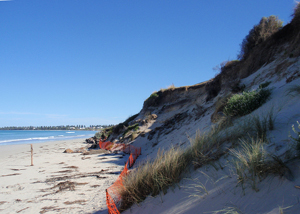Project Description
 Future climate change is predicted to increase the frequency, intensity and extent of existing coastal hazards.
Future climate change is predicted to increase the frequency, intensity and extent of existing coastal hazards.
Consequently climate change impacts are likely to exacerbate coastal erosion and inundation, potentially further increasing the impacts of these coastal hazards on existing and future coastal communities and infrastructure.
Some climate change impacts such as sea level rise are gradual and occur over very long timeframes, however extreme weather events can occur at any time and can significantly reshape the coastline. This scenario forms the basis for a general practice note published by the Victorian Department of Planning and Community Development (DPCD) on ‘Managing Coastal Hazards and the Coastal Impacts of Climate Change’.
That document, in conjunction with amendments to all Victorian Planning Schemes and the release of the Victorian Coastal Strategy 2008, represent the Victorian Government’s response to the implications of climate change on the state’s low lying foreshore areas. A significant aspect of this response is acceptance of the proposition that future climate change will have an impact on coastal areas and consequently there is a need to appropriately manage these impacts and coastal hazards.
 The obligation is placed squarely upon proponents of developments (or planning scheme amendments) to establish how the proposal is likely to be impacted by coastal hazards under climate change. This is to be demonstrated by way of a Coastal Hazard Vulnerability Assessment undertaken by suitably qualified coastal engineers or coastal processes specialists
The obligation is placed squarely upon proponents of developments (or planning scheme amendments) to establish how the proposal is likely to be impacted by coastal hazards under climate change. This is to be demonstrated by way of a Coastal Hazard Vulnerability Assessment undertaken by suitably qualified coastal engineers or coastal processes specialists
To date, Coastal Engineering Solutions has undertaken in excess of fifty CHVAs along the Victorian coastline.
In addition, our Director Dr. Peter Riedel provides specialised services to the City of Greater Geelong for the technical review of all CHVAs submitted to the Council in support of new development applications and/or planning scheme amendments.










